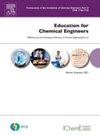Simplifying the calculation of residual properties using numerical methods
IF 2.3
2区 教育学
Q1 EDUCATION, SCIENTIFIC DISCIPLINES
引用次数: 0
Abstract
The calculation of thermodynamic properties using Residual properties (Rp) is a key element in Chemical Engineering curricula. Traditionally, the derivation of Rp involves solving analytical expressions through partial differentiation and integration of generalized thermodynamics equations combined with specific equations of state (EoS). This method is mathematically demanding, increasing cognitive load and often limiting classroom discussions to simpler EoS for which analytical solutions are readily available in textbooks. To enhance student engagement and reduce the time spent on complex derivations, we propose a simplified approach that numerically evaluates Rp using standard software tools. This approach not only minimizes the mathematical effort, allowing students to focus on thermodynamic concepts, but also extends the applicability to more complex EoS that are not covered in textbooks. By significantly reducing the instructional time required for Rp calculations, this method fosters critical thinking, promotes autonomy, and can be applied to other fundamental thermodynamics topics that traditionally rely on analytical expressions, such as multicomponent solution models.
用数值方法简化残差特性的计算
利用残余性质(Rp)计算热力学性质是化工课程的一个重要内容。传统上,Rp的推导涉及通过将广义热力学方程与特定状态方程(EoS)结合的偏微分和积分来求解解析表达式。这种方法在数学上要求很高,增加了认知负荷,并且经常将课堂讨论限制在更简单的EoS上,而这些EoS的分析解决方案在教科书中很容易找到。为了提高学生的参与度并减少花在复杂推导上的时间,我们提出了一种使用标准软件工具对Rp进行数值评估的简化方法。这种方法不仅使数学上的努力最小化,使学生能够专注于热力学概念,而且还扩展了对教科书中未涵盖的更复杂的方程组的适用性。通过显著减少Rp计算所需的教学时间,这种方法培养了批判性思维,促进了自主性,并且可以应用于传统上依赖于解析表达式的其他基本热力学主题,例如多组分解模型。
本文章由计算机程序翻译,如有差异,请以英文原文为准。
求助全文
约1分钟内获得全文
求助全文
来源期刊

Education for Chemical Engineers
Multiple-
CiteScore
8.80
自引率
17.90%
发文量
30
审稿时长
31 days
期刊介绍:
Education for Chemical Engineers was launched in 2006 with a remit to publisheducation research papers, resource reviews and teaching and learning notes. ECE is targeted at chemical engineering academics and educators, discussing the ongoingchanges and development in chemical engineering education. This international title publishes papers from around the world, creating a global network of chemical engineering academics. Papers demonstrating how educational research results can be applied to chemical engineering education are particularly welcome, as are the accounts of research work that brings new perspectives to established principles, highlighting unsolved problems or indicating direction for future research relevant to chemical engineering education. Core topic areas: -Assessment- Accreditation- Curriculum development and transformation- Design- Diversity- Distance education-- E-learning Entrepreneurship programs- Industry-academic linkages- Benchmarking- Lifelong learning- Multidisciplinary programs- Outreach from kindergarten to high school programs- Student recruitment and retention and transition programs- New technology- Problem-based learning- Social responsibility and professionalism- Teamwork- Web-based learning
 求助内容:
求助内容: 应助结果提醒方式:
应助结果提醒方式:


